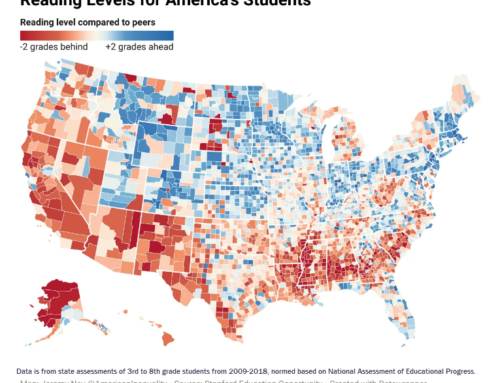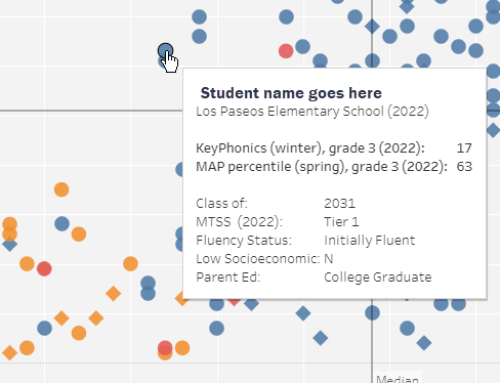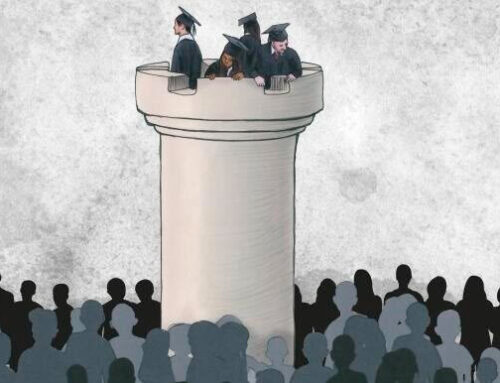Steve Gervais is an explorer. He looks for patterns … in particular, geographic patterns that could help solve riddles that school and district leaders wrestle with daily. When he learned that his district, San Bernardino City USD, was wrestling with high chronic absentee rates, he wondered if those students missing school might tend to live near each other. He built maps that proved his hunch was correct. This led to a new approach to potential place-based solutions. (Here’s where you can find a PDF of his presentation on this topic.)
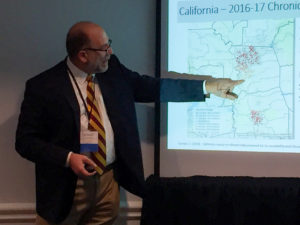
Steve Gervais, presenting his geospatial analysis work on chronic absenteeism at STATS-DC (July 2019)
When he later discovered that many of his district’s long-term English learners were clustered in a tight pattern of adjacent neighborhoods that were nearly the same as those of chronically absent students, he took this evidence to his boss, Barbara Richardson, whose title is Director of Accountability and Educational Technology. (Keep reading to learn what smart steps she took to act on this key insight.) (Here’s where you can find a PDF of his LTEL presentation.)
What makes a smart analyst?
First, he enjoys explorations. What Steve explores is data. He does so with open eyes and an open mind. He is as happy to discover that his hunch was wrong, as he is to learning his hunch was right. His curiosity drives him.
Second, he has many tools and methods at his command. He’s not a geek who’s simply in love with technical gizmos. He works hard to learn both tools and methods that he needs to solve human problems. His learning path is long, and he’s not afraid of steep learning curves. He’s taking courses and attending conferences. (Lucky for me, because I met him at a conference in Washington, D.C. called STATS-DC.)
Among the instruments he uses are maps. But not maps alone. He uses statistical analysis software. He applies methods like correlation, regression and proximity analysis. He knows which methods to apply to data to obtain measures to build evidence. And he expresses that evidence of patterns in scatterplots and heatmaps and butterfly graphs, not just maps.
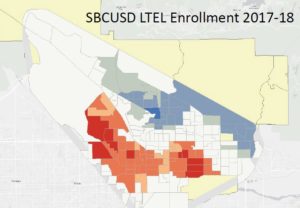
A hot spot analysis by Steve Gervais of where long-term English learners live within San Bernardino
Third, he has the habits of mind of a scientist: empirical methods, forming hypotheses, and testing them by trial-and-error. By the way, he was a scientist before he entered K12. He studied genetics, and applied it in the field of cattle-breeding. Later, he advanced his own skills independently, studying spatial science at USC and earning his MS in Geographic Information Science and Technology.
Fourth, he shares his insights effectively, and plays well with others. No surprise, he worked in teams prior to going to work for his district. He started as a classroom teacher. I’ve heard him present at two conferences, and can tell you he enjoys the conversation. Evidence of his success is clear in the lively Q&A that occurs at the end of his talks.
What makes for a district that values his talents?
I spoke with Steve’s boss, Barbara Richardson, and learned how focused she is on turning geospatial analyses and other analytic insights into action.
- Building partnerships. Handle-with-care families are being identified by building data-sharing agreements with other San Bernardino city agencies: health, juvenile justice, social services. Sharing Steve’s findings with other agencies enables the district to bring other agencies to the table to look at the shared benefits of cooperation. (Sounds similar in some ways to Geoffrey Canada’s design for the Harlem Children’s Zone.)
- Locating career pathways programs closest to students who want them. In part to respond to why some high school students miss so much school, the district learned that an advanced pathway in diesel engineering would draw many students to attend. The high cost of this program meant it had to be located in the one spot where students could most easily get to school. And it called for city and school bus systems to look at sharing the transportation work at the lowest total cost.
- Placing bilingual programs in schools where they’d be used the most. Instead of trying to spread an expensive program in equal but small amounts across a sprawling district with 75 schools, Barbara’s team is mapping these programs to the neighborhoods that would benefit from them the most.
In brief, Barbara Richardson knows how to turn insights into actions that serve their public better. That makes Steve Gervais’ analysis work a high value contributor to this district’s team. Steve’s employer, San Bernardino City USD, is enlightened to make a place in their district team for Steve and his colleagues, and support his use of analytic tools like geo-information systems.
Lessons for districts seeking talented analysts
Steve practices a specialized skill (geospatial analysis) in a hot field (data science). So he is already a rare soul. But he is among the scarcest of data scientists – those who bring their talents to K12. Every enlightened city, every police department, every hospital would love to have someone like Steve Gervais on their team. Every university. Every baseball team’s front office. Every water and power utility.
That makes people like Steve Gervais a resource that’s hard to find, hard to compete for, and perhaps hard to retain. I have just three suggestions for districts that want to bring this talent on board follow below. (Note of self-interested bias here … I lead a company that brings analytic support services to districts.)
- Pencil out the return-on-investment. You’ll learn this talent is, indeed, expensive. But what’s the relation of that cost to the value they create? Look at the challenges your district faces. Figure out what they cost you (and your students) to let them remain status quo. Then look at the dollar benefit of stepped improvements over five years, ten years, twenty years. Then you’ll know how to justify adding this classified position to your district’s team.
- Look at sharing the analytic power with other departments. Why should your department alone benefit from having an analyst on your staff? Look at San Bernardino USD. They not only shared Steve’s talents with other departments. They shared his talents with other city agencies. When you spread the benefits, you’ll win allies when the cabinet meets to consider your proposal.
- Be practical and apply analytic talent to solving your district’s riddles. Don’t pursue solutions simply for the thrill of the chase. You need to produce results. Whether that challenge is reducing wasted time reteaching things to students who already learned them, or reducing the number of LTELs who reach 9th grade unprepared to take tougher classes, pick the riddles of consequences that are suitable for analytic methods.
More power to Steve Gervais, Barbara Richardson, and the district’s leadership at San Bernardino City USD. They are not just solving their own tough riddles. They are also pointing the way for other districts to do the same.



